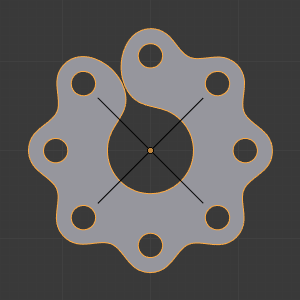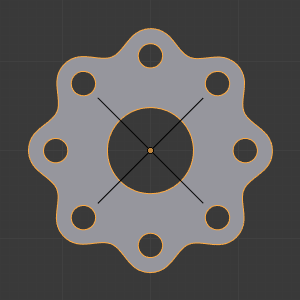Modificador Array¶
The Array modifier creates an array of copies of the base object, with each copy being offset from the previous one in any of a number of possible ways. Vertices in adjacent copies can be merged if they are nearby, allowing smooth Subdivision Surface frameworks to be generated.
This modifier can be useful when combined with tileable meshes for quickly developing large scenes. It is also useful for creating complex repetitive shapes.
Múltiplos modificadores Array podem ser ativos para um objeto ao mesmo tempo (ex. para criar construções tridimensionais complexas).
Opções¶

O modificador Array.¶
- Tipo de encaixe
Controls how the length of the array is determined. There are three choices, activating respectively the display of the Curve, Length or Count settings explained below:
- Encaixar em uma curva
Generates enough copies to fit within the length of the curve object specified in Curve.
- Encaixar no comprimento
Generates enough copies to fit within the fixed length given by Length.
- Contagem fixa
Generates the number of copies specified in Count.
Nota
Both Fit Curve and Fit Length use the local coordinate system size of the base object, which means that scaling the base object in Object Mode will not change the number of copies generated by the modifier.
Fit Curve uses the local coordinate system length of the curve, which means that scaling the curve in Object Mode will not change the number of copies generated by the modifier.
Applying the scale can be useful for both.
Relative Offset¶
- Factor X/Y/Z
Adiciona uma translação igual ao tamanho da caixa delimitadora do objeto ao longo de cada eixo, multiplicado por um fator de escalonamento, ao deslocamento. Os fatores de escalonamento X, Y e Z podem ser especificados.
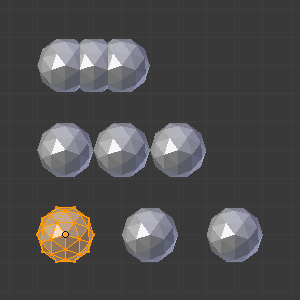
Relative offset (0.5, 1.0 and 1.5) examples.¶
Constant Offset¶
- Distance X/Y/Z
Adiciona um componente de translação constante ao deslocamento do objeto duplicado. Componentes constantes em X, Y e Z podem ser especificados.
Object Offset¶
Adds a transformation taken from an object (relative to the current object) to the offset. It is good practice to use an empty object centered or near to the initial object. E.g. by rotating this empty a circle or helix of objects can be created.
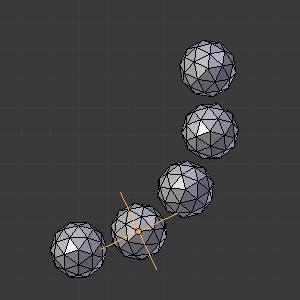
Exemplo de objeto definindo o deslocamento.¶
Fundir¶
If enabled, vertices in each copy will be merged with vertices in the next copy that are within the given Distance.
- First and Last Copies
If enabled and Merge is enabled, vertices in the first copy will be merged with vertices in the last copy, again if they are within Distance range. This is useful for circular objects.
- Distância
Controls the merge distance for Merge and First and Last Copies.
UVs¶
- Offset U/V
Shifts UVs of each new duplicate by a settable amount.
Terminações¶
- Cap Start, End
This allows either endpoints of the array to have a different mesh subsisted.
For the start: as if it was in position -1, i.e. one «array step» before the first «regular» array copy. For the end: as if it was in position n + 1, i.e. one «array step» after the last «regular» array copy.
When Merge is activated, the cap vertices within the Distance threshold will be merged.
Nota
The start/end cap objects currently do not support the First and Last Copies option.
Dicas¶
Calculação dos deslocamentos¶
The transformation applied from one copy to the next is calculated as the sum of the three different components (Relative, Constant and Object), each of which can be enabled/disabled independently of the others. This allows, for example, a relative offset of (1.0, 0.0, 0.0) and a constant offset of (0.1, 0.0, 0.0), giving an array of objects neatly spaced along the X axis with a constant 0.1 unit between them, whatever the original object’s size.
Examples¶

A chain created from a single link. Sample blend-file.¶
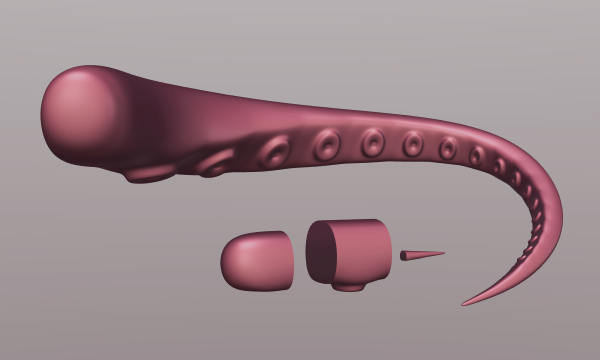
A tentacle created with an Array Modifier followed by a Curve Modifier.¶
The segment in the foreground is the base mesh for the tentacle; the tentacle is capped by two specially-modeled objects deformed by the same Curve object as the main part of the tentacle. Sample blend-file.
Fractal¶
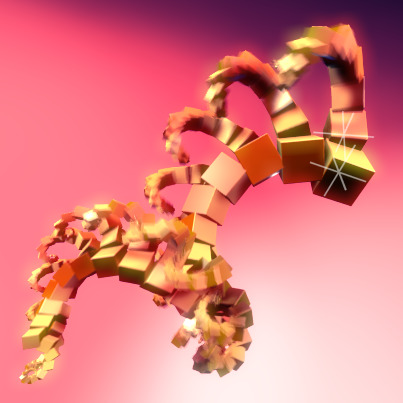
Multi-level array animated with motion blur.¶ |
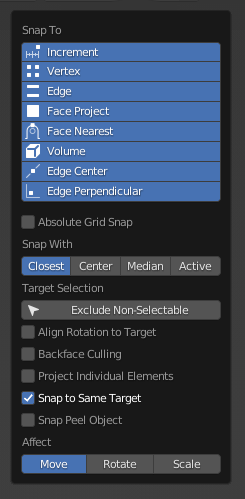
Fractal created with multiple arrays. Sample blend-file.¶ |
